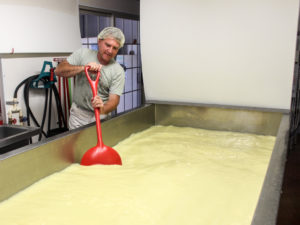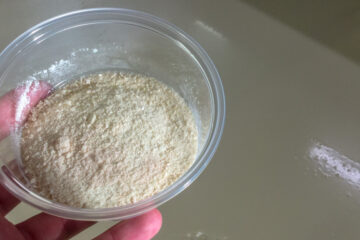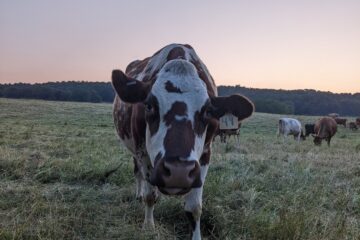
“Little Miss Muffet sat on her tuffet eating her curds and whey.” You probably know the rhyme, but what are curds and whey? Where do they come from, and what do they have to do with making cheese? Without curds and whey, we would never get cheese. But first, we need rennet.
Rennet is an enzyme that comes from calf stomachs. The enzyme interacts with milk, making it easier for calves to digest. We follow the tradition of using real animal rennet in cheesemaking. Vegetable rennet is a genetically-engineered fungus, which gives aged cheeses a bitter aftertaste.
As we explained in the last post in the series, we monitor the pH levels and the time to make sure the cultures we added are working and acidifying the milk. Then we add rennet to coagulate the acidic milk. Coagulate just means the milk gets firm like jello or yogurt, so we can separate the curds and whey. We pour the rennet across the vat and stir it into the milk. Then we wait for the milk to thicken.
Once the milk turns solid (usually within a half-hour), we use a special tool called a cheese harp. It is very similar to the musical instrument, with a stainless steel frame and thin wires running vertically. We have two harps. The first one has its wires one inch apart for making softer cheeses, which retain more moisture in larger curds. The second harp’s wires are only 3/8 inches apart for our harder cheeses. We run the harp through the vat in three directions to cut the solid mass into small cubes. Watch the video below to see a close-up view of the first cut.
We now have curds and whey! The small cubes, which continue to shrink as they lose moisture, are the cheese curds. The whey is the yellowish liquid that the curds float in throughout the cooking process. After cutting, we allow the curds a few minutes to rest from being broken into cubes, and then we start stirring and heating the cheese vat. We stir the curds to make sure they heat up evenly. The heating process helps the whey to separate from the curds, and it controls the biological activity of the cultures.

In the steps covered in this series so far, the cheese-making process is very similar for all styles. However, from this point forward, our cheese-making process will vary depending on what particular style we are making that day. This series will first follow our process for making Clover (our cheddar) since it is one of our most popular (and complicated) cheeses.
NEXT: Cheddar is a Verb



0 Comments